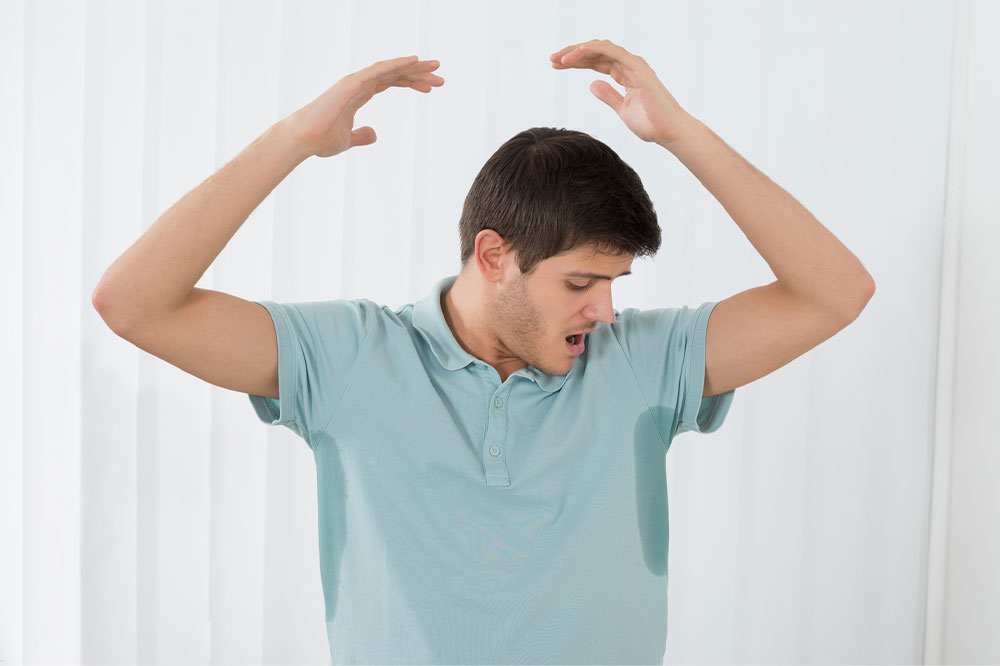
Hyperhidrosis – Causes, symptoms, and management
Hyperhidrosis is a health condition characterized by excessive sweating but is not triggered by physical activity or heat. The condition commonly affects areas like palms, armpits, face, chest, and the soles of one’s feet. Heavy sweating due to hyperhidrosis can affect one’s social interactions. However, there are treatments and remedies to manage the condition. Keep reading to learn more about hyperhidrosis, its causes, symptoms, treatments, and natural remedies to manage it.
Causes
There are two categories of hyperhidrosis – primary and secondary. Sweating is your body’s cooling mechanism when it turns hot (you are nervous, sick, or exercising). Nerves trigger your sweat glands to start functioning. When someone has hyperhidrosis, some sweat glands overwork for no apparent reason, generating excess and unwanted sweat. Some of the causes of primary hyperhidrosis are listed below.
- Spinal cord injury
- Heat
- Anxiety or emotional stress
- Some foods and odors, such as coffee, peanut butter, citric acid, spices, and chocolate
When a person has secondary hyperhidrosis, a prescription or non-prescription treatment or a health condition makes them sweat excessively. However, researchers or scientific experts are yet to uncover what triggers extra sweat in focal hyperhidrosis. Some of the causes of secondary hyperhidrosis are-
- Humidity, physical activity, and heat
- Dysautonomia
- Infections like Tuberculosis
- Psychological stress
- Menopause
- Conditions like lymphatic system cancer or Hodgkin’s disease
- Certain prescription treatments
- Metabolic disorders like diabetes, pheochromocytoma, hypoglycemia, and hyperthyroidism
Symptoms
Hyperhidrosis can lead to the following symptoms –
- Sweating while sleeping
- Excessive sweating that begins when you are younger than 25
- Sweating that interferes with your routine
- Episodes of hyperhidrosis at least once a week
- Sweat that forms on both sides of the body, typically in the same amount
- Sweating that has been persistent for at least six months for no evident reason
All of these symptoms indicate primary hyperhidrosis in a person. If one notices these symptoms, it is advised to consult a healthcare professional to get an accurate diagnosis. However, when you sweat excessively or all over in one area, it indicates that you have secondary hyperhidrosis. In this case, consult a doctor to determine the underlying cause. Some health conditions linked with excessive sweating can be severe. Therefore, keep your healthcare provider updated whenever you experience any other unusual symptoms with sweating.
When to consult a health expert?
Excessive sweating can indicate other severe health conditions. So, call your doctor if you undergo-
- Body mass loss with sweating
- Unexplained and prolonged sweating
- Sweating, chest pain, or a feeling of pressure in the chest
- Sweating that usually occurs when you sleep
- Sweating with shortness of breath, chest pain, rapid heartbeat, and fever
Diagnosis
Health experts can diagnose hyperhidrosis by a physical examination or by inquiring about the patient’s history. Furthermore, they can also assess the sweating level in two different ways-
- Vapometer – This closed chamber device measures transepidermal water loss and evaluates the degree of sweat your feet, underarms, hands, and scalp make. Calculating the sweat amount gives the health expert an objective way to compare the sweat pre and post-treatment.
- Starch iodine test – It is a test that changes the sweat color to detect excessive sweating.
Treatment
Natural remedies
A few natural remedies that can help manage the symptoms are listed below.
- Clothing – Some synthetic fibers like nylon aggravate the symptoms. So, replacing these with loose clothing can help.
- Antiperspirants – Antiperspirants spray can help manage excessive sweating more effectively than deodorants. One can opt for prescription options that plug the sweat glands.
- Socks – Some socks are good at absorbing moisture. These include soft, thick socks made of natural materials.
- Armpit shields – These are pads worn in the armpit to protect the clothing from sweat.
- Shoes – Synthetic materials aggravate the symptoms. In such scenarios, natural alternatives like leather can help.
Therapy
Treatment for hyperhidrosis typically starts with antiperspirants. However, if these do not work, one can try alternatives like therapies or prescription remedies. In extreme cases, a healthcare professional might advise surgery to remove the sweat glands or disconnect the nerves associated with producing excessive sweat. You may require healthcare intervention if the natural remedies fail . A health expert may refer you to a dermatologist or skin specialist who may advise the following-
- Endoscopic thoracic sympathectomy – Also known as ETS, Endoscopic thoracic sympathectomy is a surgical treatment option for severe hyperhidrosis cases when no other treatments work. Here, the doctor cuts the nerves carrying messages to the sweat glands. ETS can help cure hyperhidrosis of the armpits, face, or hands. However, it cannot treat the hyperhidrosis of the feet, as it may result in severe complications.
- Iontophoresis – Under this treatment, your feet and hands are dipped in a water bowl, and an electric current (usually painless) is passed through the water. Usually, patients will start seeing a difference in two to four 20-30 minute sessions.
- Topical treatments- Prescription antiperspirants or creams and wipes can help with hyperhidrosis of the face and head.




